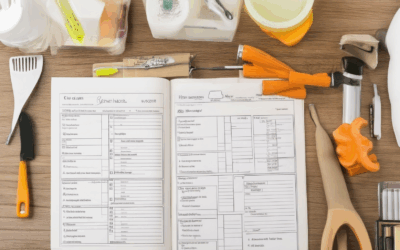Seasonal home repair projects are an essential part of maintaining a healthy and comfortable living environment throughout the year. Whether it’s preparing your home for winter, addressing plumbing issues, inspecting your roof, or planning for spring cleanup, staying proactive with regular maintenance tasks can save you from costly repairs down the line. This comprehensive checklist offers a detailed guide to tackling seasonal home repair projects with ease and efficiency, ensuring your property remains in top shape year-round. From minor fixes to major renovations, discover the best times to address various home repair needs and learn how to prioritize tasks to maximize productivity. Keep your home in prime condition with this ultimate seasonal home repair projects guide!
Key Takeaways
- Winter Home Renovations: Refresh your kitchen with new countertops, cabinetry, or flooring; install new bathroom tiles or redesign your shower; address basement flooring and wall repairs.
- Basement Improvements: Install moisture-resistant flooring and fix damaged walls or ceilings.
- Window and Door Replacement: Replace old windows with energy-efficient models and install storm doors for added protection.
- HVAC Systems: Upgrade your furnace for improved efficiency and clean your ductwork for optimal heating performance.
- Electrical and Plumbing Projects: Update lighting fixtures and insulate pipes to prevent freezing.
- Contractor Activities: Contractors focus on roofing repairs, HVAC maintenance, insulation, electrical work, interior renovations, landscaping, plumbing, and window replacement.
- Most Popular Month for Renovations: June is the busiest month, driven by favorable weather, vacation time, and higher disposable incomes.

Understanding the 30% Rule in Home Renovation
The 30% rule is a useful guideline for homeowners planning renovations, offering a framework to manage expenses and maintain equity. Here’s a breakdown:
- Definition: The 30% rule suggests spending no more than 30% of your home’s current value on renovations.
- Calculation: Determine your home’s current value through an appraisal. Multiply this value by 0.3 to find your renovation budget cap.
- Purpose: This rule aims to prevent overspending, protecting your financial stability and equity. It ensures your renovation doesn’t exceed what the market values, helping maintain or boost your home’s worth.
- Scope Consideration: While the rule applies generally, adjustments may be needed for specific projects. Larger additions like decks or kitchens might warrant closer attention to this guideline.
- Practical Application: For minor fixes like repainting, the rule may be less strict. However, for major overhauls, sticking to the 30% limit is advisable.
- Professional Advice: Consulting real estate agents or financial advisors can provide tailored insights, especially for complex projects or unique market conditions.
By adhering to the 30% rule, you can manage your renovation budget effectively while safeguarding your home’s equity. Consider getting a current appraisal and seeking expert advice to tailor this guideline to your specific needs.
What is the Most Common Home Improvement Project?
Home improvement projects vary widely depending on individual preferences, budget, and property condition. However, certain projects consistently stand out as the most popular among homeowners due to their versatility, ROI potential, and ease of execution. Below, we explore the most common home improvement projects and why they remain top choices for many.
Top 5 Most Common Home Improvement Projects
- Painting: Whether it’s walls, ceilings, or woodwork, painting is one of the simplest yet most impactful home improvements. According to recent surveys, approximately 45% of homeowners choose painting as their primary project, making it the most common.
- Redecorating: Rearranging or updating room layouts and furniture arrangements is another popular project. With 38% of homeowners focusing on interior design, this category encompasses everything from wallpaper changes to new window treatments.
- Kitchen Remodeling: Kitchen upgrades rank high on the list, with nearly 38% of homeowners investing in this space. This includes cabinet refacing, new countertops, and modernized appliances.
- Bathroom Renovation: Small yet impactful, bathroom remodels are a favorite among homeowners. Tile replacement, new fixtures, and updated vanities are among the most common upgrades, appealing to 30% of renovators.
- Landscaping: Exterior improvements like landscaping and outdoor enhancements are increasingly popular. 25% of homeowners invest in yard work, deck installations, or patio upgrades to boost curb appeal and functionality.
Why These Projects Are So Popular
The popularity of these projects stems from several factors:
- Cost-Effectiveness: Many home improvement projects, like painting and landscaping, offer a relatively low cost compared to larger-scale renovations.
- Quick Turnaround: Projects such as kitchen and bathroom remodels often deliver quick results, making them ideal for those seeking immediate gratification.
- High ROI: Some projects, particularly kitchen and bathroom remodels, consistently yield high returns on investment when executed properly.
- Personalization: Homeowners can tailor these projects to their unique tastes, whether through color choices, layout changes, or custom designs.
Trends in Home Improvement
Recent years have seen a shift toward sustainable and energy-efficient home improvements. From installing solar panels to upgrading HVAC systems, eco-conscious projects are gaining traction. Additionally, the rise of DIY culture has made projects like painting and small-scale remodels more accessible than ever before.
Sams Maintenance encourages homeowners to explore these options while considering professional assistance for complex tasks. Our resources provide detailed guides and expert advice to help you tackle these projects confidently and effectively.
Whether you’re aiming for a quick refresh or a full renovation, these top home improvement projects offer something for everyone. Start planning your next project today and transform your living space into something extraordinary!
Learn more about our home improvement services .

What to Do When You Can’t Afford a Home Repair?
If you’re struggling to afford necessary home repairs, there are several options and resources available to help you address the issue. Here’s a step-by-step guide to finding solutions:
- Reach Out for Assistance
- Contact local nonprofits or community organizations that may offer free or discounted repair services.
- Visit Habitat for Humanity for potential assistance with home repairs.
- Check with Rebuilding Together for free home repair programs.
- Apply for government assistance programs like FEMA’s Individuals and Households Program .
- Explore Affordable Financing Options
- Research local home improvement loans or grants available for low-income families.
- Look into HUD programs for affordable housing solutions.
- Contact your local housing authority for information on rent-assisted housing or repair programs.
- Consider DIY Solutions
- For minor repairs, try DIY fixes to temporarily resolve the issue while planning for professional help.
- Fix small leaks, patch walls, or replace faulty hardware with basic tools and materials.
- Seek Professional Assistance
- Contact local trade schools or vocational programs for affordable labor from students or apprentices.
- Ask about community service organizations or churches that may offer volunteer handyman services.
- Search for local handyman services or contractors who may offer discounts or sliding-scale pricing.
- Check With Utility Companies
- Some utility companies offer free inspections or repairs for plumbing, electrical, or HVAC systems.
- Contact your gas, electric, or water provider to inquire about available assistance programs.
- Crowdfunding
- Consider crowdfunding platforms like GoFundMe to raise funds for necessary repairs.
- Share your story and appeal to your community for support.
- Prioritize Repairs
- Assess the urgency of repairs to minimize potential damage or health risks.
- Address critical issues like plumbing, roofing, or structural problems first.
- Create a priority list of repairs based on safety and functionality.

Can You Do Home Renovations in Winter?
Yes, you can absolutely perform certain home renovations during the winter months. While many people assume that home improvements are best left for warmer seasons, winter can actually be an ideal time for specific projects. Here are some ideas and tips to help you get started:
1. Interior Remodeling
- Kitchen Updates : Winter is an excellent time to refresh your kitchen. Consider upgrading your countertops, cabinetry, or flooring. These projects are less affected by weather conditions and can be completed efficiently.
- Backsplash Installation : Adding a new backsplash can transform your kitchen while providing a durable and stylish finish.
- Appliance Replacement : Upgrading your appliances can enhance functionality and energy efficiency, making your home more comfortable year-round.
2. Bathroom Renovations
- Tile Replacement : Winter is perfect for installing new bathroom tiles. This project can modernize your space and provide a fresh look.
- Shower Redesign : If your shower needs an update, winter is a great time to install new fixtures or reconfigure your shower space.
3. Basement Improvements
- Flooring Installation : Installing new flooring in your basement can add warmth and comfort to your home. Choose materials that are moisture-resistant to handle the cooler temperatures.
- Walls and Ceiling Repairs : Address any damage or peeling paint in your basement walls or ceiling during the winter months.
4. Window and Door Replacement
- Energy-Efficient Windows : Replacing old windows with energy-efficient models can improve your home’s insulation and reduce heating costs.
- Storm Doors : Installing storm doors can provide added protection against the cold and harsh winter winds.
5. Heating and Ventilation Systems
- Furnace Replacement or Upgrade : If your furnace is outdated or inefficient, winter is the perfect time to replace it with a newer, more efficient model.
- Ductwork Cleaning : Clean your ductwork to ensure your heating system is working efficiently and circulating clean air throughout your home.
6. Electrical and Plumbing Projects
- Lighting Updates : Install new lighting fixtures or fans to improve the ambiance and functionality of your living spaces.
- Pipe Insulation : Insulate exposed pipes in your home to prevent freezing and reduce the risk of plumbing issues.
Tips for Winter Renovations:
- Stay Warm : Work in short shifts and take breaks often to stay comfortable. Dress warmly and consider using space heaters in colder areas.
- Protect Your Pipes : Keep cabinet doors closed and run water regularly to prevent pipes from freezing.
- Plan Ahead : Order materials early to avoid delays caused by winter weather.
By tackling these projects during the winter months, you can enjoy a more comfortable and updated home without waiting for warmer weather. Remember to check local building codes and hire professionals if needed to ensure safety and quality.
Home Depot offers a wide range of tools and supplies for your winter renovation projects, while Lowe’s provides expert advice and installation services. For more ideas, visit Menards .
What Do Contractors Do in the Winter?
Contractors remain active during the winter months, offering a variety of services tailored to the season’s unique needs. Here’s a breakdown of what they typically do:
- Roofing: Contractors often focus on roof repairs and replacements during winter. The cooler temperatures and drier air make it ideal for applying roofing materials, ensuring a seamless installation.
- HVAC Installation and Maintenance: With heating systems running consistently, contractors provide routine maintenance and installations. This includes furnace checks, ductwork cleaning, and new system installations before ground freezing.
- Insulation and Energy Efficiency: Homeowners may opt for attic insulation, basement waterproofing, or soundproofing to enhance energy efficiency, which is easier to accomplish in the winter months.
- Electrical Work: Indoor electrical projects, such as outlet installations, wiring fixes, and smart home setups, are popular winter tasks, unaffected by adverse weather conditions.
- Interior Renovations: Tasks like wall painting, flooring installation, and cabinetry can be completed indoors, making them ideal for the winter season.
- Landscape Preparation: Contractors prepare lawns for spring by clearing debris, leveling soil, and installing new sod. They may also set up irrigation systems or outdoor lighting.
- Plumbing Services: Year-round plumbing needs include pipe installations, leak repairs, and frozen pipe thawing. These tasks are efficiently handled indoors during winter.
- Window Replacement: Installing new windows can be done at any time, but winter provides a less disruptive environment, especially for those spending more time indoors.
Why Hire Contractors in Winter?
Homeowners may find contractors available and willing to offer discounted rates due to slower demand. Additionally, winter-specific projects can prevent future issues, making it a cost-effective time for renovations.
Tips for Choosing Contractors
Always check credentials, request multiple quotes, and verify insurance coverage. Look for companies with a proven track record and read reviews to ensure reliable service.

What is the most popular month for home renovations?
Summer is typically the most popular season for home renovations, with June being the busiest month for contractors. Homeowners often take advantage of the warmer weather and extended daylight hours to tackle larger projects. Additionally, many families use the summer break from school and work to plan and execute renovations.
Factors contributing to the increased demand include:
- The availability of vacation time during the summer months
- Higher disposable incomes after holiday spending
- Better weather conditions for outdoor work
- Increased motivation to refresh and update living spaces
June is particularly busy due to the combination of school ending and families wanting to get started on remodels before the next school year begins. This trend varies slightly by region, but overall, summer remains the peak season for home renovations.
Conclusion: While preferences may vary by location, June through August is the most popular timeframe for home renovations in many parts of the country.




0 Comments